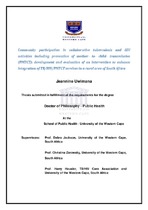| dc.description.abstract | The epidemiological interconnectedness of tuberculosis (TB) and human immunodeficiency virus (HIV) epidemics is well documented. Although international agencies such as the World Health Organisation (WHO) have been advocating for the implementation of collaborative TB/HIV activities at all levels in order to mitigate the impact of the dual epidemic on communities, health care delivery and programme management, its implementation has been very slow, particularly in countries highly burdened with TB/HIV infection, such as South Africa. Provision of integrated TB/HIV services has been partial and sub-optimal at community level. This requires innovative interventions that go beyond health facility boundaries such as engaging community care workers (CCWs). This thesis presents ways of engaging community members such as CCWs in collaborative TB/HIV activities including prevention of mother-to-child transmission of HIV (PMTCT). Methods: Both action research and health systems strengthening research were
used as theoretical frameworks. The study was conducted in three phases which
consisted of: a situational analysis; design and implementation of the intervention;
and evaluation of the intervention. Mixed method research using both quantitative
and qualitative research methods in one study was conducted, and various research
designs were used depending on the research questions and the study phases.
Results: The findings of Phase I of this study highlight partial integration of
TB/HIV/PMTCT services at facility and community levels, and sub-optimal provision
of integrated services, particularly at community level where only 10% of TB and HIV patients needing care at community level were supported by CCWs. Most TB-HIV co-infected patients were managed at the primary health care (PHC) clinic level of care, compared to other levels (p<0.05), and less than 50% of PHC clinic staff were trained in TB and HIV management. This phase also indicates poor linkage between facility and CCWs through the nongovernmental organizations (NGOs) managing CCWs. In addition, it identifies various health systems barriers that impede the implementation of collaborative TB/HIV/PMTCT activities and involvement of CCWs in the mainstream of the primary health care system. The findings of Phase II and III show that integrating different CCW cadres into one cadre and expanding their scope of practice to provide a comprehensive package of care for TB/HIV/PMTCT is a feasible and an effective intervention to accelerate the implementation of collaborative TB/HIV activities, including PMTCT, at community level. In addition, the findings suggest that up-skilled CCWs contribute significantly to bridging the current service delivery gaps in vertical TB, HIV and PMTCT services by increasing coverage for case finding of TB (38%) and sexually transmitted infections (STIs) (40%), PMTCT services (infant feeding, referral for PCR and AZT adherence support) (30%), and TB and antiretroviral treatment (ART) adherence (30%, 28%). The increase in uptake of TB/HIV/PMTCT services was statistically significant (p<0.05). Provision of home-based HIV counseling and testing by CCWs proved to be acceptable and feasible. Of 684 people offered home based HCT, 634 (82%) accepted to be tested and 45 (7%) tested HIV positive. However, other PHC care services such as integrated management of childhood illnesses (IMCI) and referrals to social welfare were poorly provided. Conclusion and Recommendations: The findings indicated that up-skilling CCWs resulted in improvement of CCW's performance in provision of integrated TB/HIV/PMTCT services, particularly for TB and STI symptom screening, HCT, infant feeding counselling and AZT treatment support for PMTCT, and treatment adherence support for TB and ART. However, this study emphasised the need for addressing contextual and health systems issues such as structural, organisational and managerial constraints. There is a need to reorganise the PHC system to ensure that CCWs are integrated as part of the PHC system. Systematic skills building and consistent CCW supervision, with reliable referral and monitoring and evaluation (M&E) systems are required for efficiency and sustainability of any community based intervention. It is also necessary to ensure that other PHC activities, such as referral for social welfare and IMCI, are not compromised when additional activities are added to the CCW care package. | en_US |

